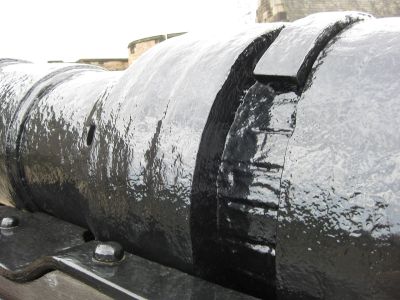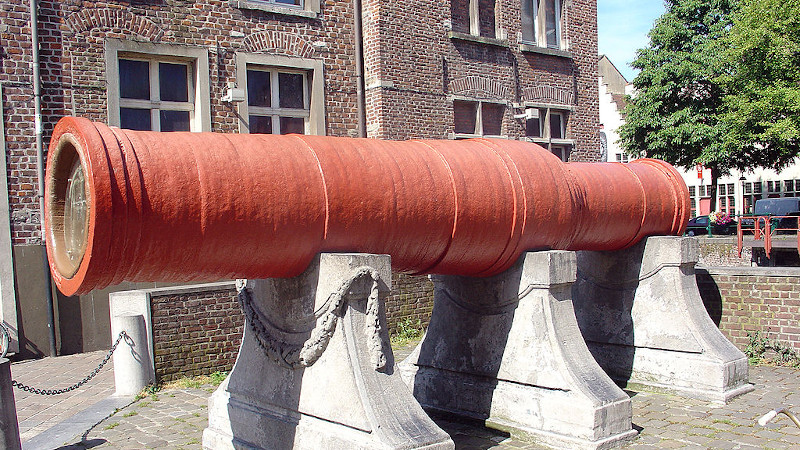For a happy weekend away in early September, I joined a few of my continental friends for the NewLine event organised by Hackerspace Gent in Belgium. You may have seen some of the resulting write-ups here, and for me the trip is as memorable for the relaxing weekend break it gave me in a mediaeval city as it is for the content of the talks and demonstrations. We took full advantage of the warm weather to have some meals out on café terraces, and it was on the way to one of them that my interest was captured by something unexpected. There at the end of the street was a cannon, not the normal-size cannon you’ll see tastefully arranged around historical military sites the world over, but a truly massive weapon. I had stumbled upon Dulle Griet, one of very few surviving super-sized 15th century siege cannons. It even had a familiar feel to it, being a sister to the very similar Mons Meg at Edinburgh Castle in Scotland.
How Do You Contain A Small Bomb With Wrought Iron?
There is probably enough material in the wars and sieges in which these guns would have been employed to furnish a history PhD or two and at least one earnest historical documentary, but for me there was another entirely separate source of interest. This cannon was made in an age when firing a cannon was in itself a risky business, so how did the metalworkers who made it ensure that it was strong enough to contain the explosion of its charge? Probably the closest modern equivalent can be found in a 20th century naval gun, something which archive films show as being manufactured from single cast billets by forging around a former with a steam hammer. Those barrels would have used specific steels selected for their metallurgical properties, and processes and machinery simply unavailable in earlier centuries.

The answer can be seen on closer inspection, especially so with Scotland’s Mons Meg. Instead of being manufactured from a single billet these weapons are constructed from individual wrought iron staves held in place by iron hoops in much the same way as the wooden staves of a traditional barrel are assembled into a whole. This material, manufactured by an extremely labour-intensive process of repeatedly working pig iron, has the required strength and elasticity to withstand extreme forces, but for all that the barrel remains a composite of multiple separate pieces. It’s fascinating to me as someone who grew up around metalwork to see the very significant level of skill that went into producing and assembling these parts without mechanical assistance except possibly from rudimentary water hammers. The British TV show Time Team produced a very small scale replica barrel for one a few years ago, which you can see below the break. From the video you can see today’s smiths could match the production, but it’s the skill of making the high quality wrought iron that’s largely been lost.
Dulle Griet was used by the Gent city state in its campaigns, before being captured by one of their adversaries. It survives in one piece which is more than can be said for Mons Meg, which burst one of its iron rings during a ceremonial firing in 1680. There’s a question as to whether these guns (like the super-sized aircraft carriers of today) had as much symbolic value of projecting the most power for their owners alongside their military value, but one thing’s for certain: to be on the side facing their fire would not have been a pleasant experience.
Dulle Griet can be inspected by anyone with a few minutes as they walk the streets of Gent, while to see Mons Meg requires tourist entry to Edinburgh Castle.
Header image: Karelj, Public domain.

















Now they made a barrel, but how would they cap it, such that the cap wouldn’t be blasted off?
Good question. Found this…
https://www.britannica.com/technology/military-technology/The-development-of-artillery
“Forging a strong, gastight breech presented a particular problem that was usually solved by welding a tapered breech plug between the staves.
Hoop-and-stave construction permitted the fabrication of guns far larger than had been made previously. “
My impression is that there isn’t much lost knowledge in making wrought iron, it’s just back-breaking, toxic, and not amenable to automation. Like the use of kuromido in japanese goldsmithing, wrought iron is no longer a common thing because the physical danger involved in its manufacture outweighs any possible utility.
“Instead of being manufactured from a single billet these weapons are constructed from individual wrought iron staves held in place by iron hoops in much the same way as the wooden staves of a traditional barrel are assembled into a whole.”
And this is, in fact, why a gun tube is called a “barrel”!
Whoa. That’s enlightening!
Closer to traditional cannon manufacture would be the built up guns of WW2, where the barrel is a series of layers that compress the internal liner. Some built up guns were wire wound, while others used shrunk on and pressed cylinders to provide the same sort of strengthening that the rings on older cannons did.
https://en.m.wikipedia.org/wiki/Jaivana_Cannon
Up close, this is truly mammoth
Who films a TV rather than using direct capture?
+ points for Time Team even if the sound was dodgy.
King James II of Scotland got Mons Meg as a gift from his father-in-law in Burgundy. James was an artillery enthusiast and had a collection of state of the art artillery mainly imported from Burgundy (the centre of excellence for such things back then)
In 1460 he was killed by one of his own cannon when it exploded close to him when he was laying seige to Roxburgh.
It would have been good to have a human or something in the title photo for scale… From the wikipedia link, the calibre is 64cm. So a person could fit down that barrel.